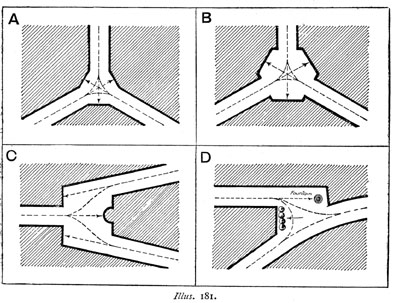
VOL. 4, NO. 4 -- WINTER 2002
Unwin's Intersections
In 1909, city planners designed, and wrote, with a
greater love of form. For evidence, look no further than Raymond Unwin's
introduction to the four drawings pictured here:
"Indeed, when once attention is given to the subject, there are many ways
in which street junctions can be treated, either to secure open vistas
or closed-in pictures, as may in each case be desirable. . At first sight
some of these irregular shapes seem to have no purpose or meaning, but
closer examination of them will show that they are cunningly devised.
."
At a time when concern for the figural pervaded both painting and prose,
planners designed for beauty as well as function. Raymond Unwin, one of
the giants of the Garden City movement, presented these intersections
and a dozen others in his book, "Town Planning in Practice," which remains
one of the most useful urban design manuals ever published. As Unwin suggests,
the beauty of these intersections - an inseparable part of their function
- reveals itself upon closer inspection, specifically when you lift the
book up to your nose, place yourself within the drawing, and observe how
framed vistas are terminated by prominent building facades that anxiously
await the traveler's eye. These "terminated vistas," a hallmark of the
picturesque planning tradition, are the memorable occasions that allow
visitors to find their way around while providing suitable honorific sites
for civic buildings. Their marked absence in most post-war developments
plays no small role in the disorienting nature of the contemporary city.
These intersections, like much of traditional urbanism, are of little
interest to the current generation of technocrat planner, a breed that
does not share Unwin's formal concerns. To make matters worse, they are
typically illegal, thanks to traffic engineers who, designing for the
drunk at midnight, tend to reject them on sight. Such intersections are
rarely allowed, even in old towns that are full of good existing examples.
Interestingly, those that have been studied are statistically safer than
the standard Department of Transportation model, precisely because they
don't feel safe at high speeds. The complex geometries tell drivers that
care is required, and they slow down. These studies need to be collected
and promoted so that, someday, when the planning and engineering professions
regain consciousness, designers who care can bring back such intersections
to a citizenry starved for meaningful urban form.
 Unwin's intersections were designed to create meaningful urban forms with terminated vistas, a hallmark of the picturesque planning tradition. Credit: "Town Planning Practices," by Raymond Unwin. |
Jeff Speck is co-author of "Suburban Nation: The Rise of Sprawl and the Decline of the American Dream" (2000, North Point Press). This article written by Jeff Speck will be included in the March 2003 issue of "The Ganzfeld," an annual book of visual culture. For more information, visit www.theganzfeld.com.